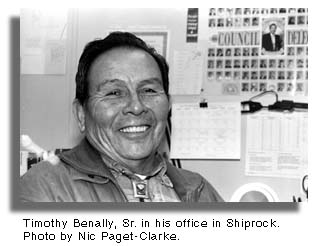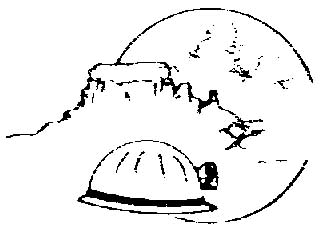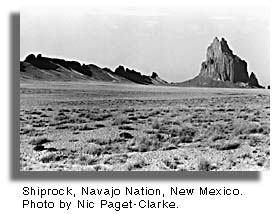Navajo Uranium Miners
Fight for Compensation
by Timothy Benally, Sr.
Shiprock, Navajo Nation, New Mexico
 The following article is based on an interview conducted in the Navajo Nation in Shiprock with the director of the Office of Navajo Uranium Workers Timothy Benally Sr. - December 29, 1993. Interview by Nic Paget-Clarke. The following article is based on an interview conducted in the Navajo Nation in Shiprock with the director of the Office of Navajo Uranium Workers Timothy Benally Sr. - December 29, 1993. Interview by Nic Paget-Clarke.
To read personal stories by miners and their families go to: Memories Come To Us In the Rain and the Wind, Oral Histories and Photographs of Navajo Uranium Miners & Their Families
On the reservation back in the '40s and the '50s, jobs were pretty scarce. In 1958, I had just returned from the Armed Services. I couldn't find a job and I had the chance to get into the mines. The first time, after about 3 months, I complained about the safety of the mines. The boss didn't like it so he said at the end of the work week, "Don't come back Monday." So I didn't.
Then the mine ownership changed. Kerr-McGee took over, and I applied for a job and got work again. Again I complained, this time about the wages. I said the federal law requires that the workers be paid $1.25/hr. and these people are getting anywhere from 80 to 90 cents/hr. for their labor. Again I got fired.
Mining the Navajo Nation
 Mining here started as early as 1918 around the Carrizo Mountain area, which is just about 30 miles west of Shiprock. They first mined vanadium and then they discovered uranium, more by accident. Mining here started as early as 1918 around the Carrizo Mountain area, which is just about 30 miles west of Shiprock. They first mined vanadium and then they discovered uranium, more by accident.
At that time, uranium was not the ore that was mined. They did'nt know what it was so they just kept a lot of the stuff around in those mines. One of my constituents says that they had uranium in gunny sacks stacked in the trading post at Beclahito. It had been there for a number of years before they found out what it was.
Right after World War II, when the government found out what uranium can do, they decided to mine some of those areas and a lot of it was found on the reservation. People just went crazy looking for uranium, prospecting all over the reservation.
The Vanadium Corporation of America and Kerr-McGee were the principal owners of these mines and they have taken advantage of the Navajo workers. Not only with paying low wages, but by not informing the workers about the hazardous effects that uranium has on their lives.
Here they probably thought we were expendable so they just said go ahead and put them to work and not worry about them, their health or the effects of the radiation. We were just used in that manner. And not only us, in Utah one of the former miners said he lost one side of his lung. The radiation is working on the other side now. He said he felt that the miners were used as guinea pigs, and that's what I think actually happened.
 Uranium Radiation Victims Committee Uranium Radiation Victims Committee
They never bothered telling anybody about it, and people just worked there. By early 1960, people who worked there the longest began to get sick. Eventually many of them died, and the people, the family members, the widows and the children got real concerned.
People talked about it and finally they organized themselves into a union. They started having regular meetings and after some time they consulted with some legal services and worked with them. In that process they got involved with more and more people. The group, the Uranium Radiation Victims Committee, provided education to people of how uranium was hazardous, but often people wouldn't listen to them because of the work situation -- there was no other employment.
The end result has been this group pursued compensation for their loss. "We went to the Arizona State Court then to the Supreme Court level, and lost all the way. We started again in the federal court and lost again all the way to the Supreme Court. At that time we turned to Congress and Congress heard our complaint and thought it was legitimate," they said. In 1978 they floated a bill in the Senate. Pete Domenici from New Mexico sponsored the bill and it was defeated. Pete Domenici said we had to go after it again. We made it a partisan bill and we incorporated other states - Colorado, Arizona, Utah, Wyoming and New Mexico. The representatives from some of these states made some compromises on their original bill and we introduced a bill for radiation compensation that was passed in 1990.
Navajo Uranium Workers
The Navajo Tribal Council had been aware of all these goings on, so in April 1990 they established this Office of Navajo Uranium Workers. They wanted the statistics on the number of miners that we've had. So that's our job, to register Navajo uranium workers. Also we provide comprehensive medical care for living miners and keep the Navajo public informed about the development of the program.
We have today registered 2,450 eligible Navajo uranium workers. Eligible meaning that they worked between January 1, 1947 and December 31, 1971. Also we had 412 deceased miners from way back, those that began the mining process. Every month one or two more die.
There are other tribes that had some mines during this period who are also eligible for the compensation.
The Navajo Nation president has put a moratorium on the uranium mining.
Responsibility
These mine operators, these mill operators, they were not held responsible because they said we just did the mining for the government, and the government is the one that's responsible for it. But the Navajo people that live on the reservation, complained about the damages that were done by the mining.
As well as the harm to the miners, the Navajo people say the operators went up into the mountains and pushed a lot of the dirt that contained some radiation or uranium off the side of the mountains and they were just scattered down below. When it rains and when it thaws in the springtime, a lot of the water washes into the riverbed and flows down into the stream and eventually comes out on the farms and does other damage. It's like a chain reaction. The food you raise may have some radiation, and you eat it. They feel that a lot of this is taking place right now because of the way they handled the initial mining.
Human Radiation Experiments
Currently, Office of Navajo Uranium Workers staff has been working on an amendment of the Radiation Exposure Compensation Act (RECA) legislation so it will be easier for miners to qualify. We testified before the Advisory Committee on Human Radiation Experiments, and the committee will make a recommendation to the president to liberalize RECA legislation.
Several conferences have been held on Navajo Nation with the miners, relatives, and others in this change request in RECA. It looks very good.
Also read:
|



 The following article is based on an interview conducted in the Navajo Nation in Shiprock with the director of the Office of Navajo Uranium Workers Timothy Benally Sr. - December 29, 1993. Interview by
The following article is based on an interview conducted in the Navajo Nation in Shiprock with the director of the Office of Navajo Uranium Workers Timothy Benally Sr. - December 29, 1993. Interview by  Mining here started as early as 1918 around the Carrizo Mountain area, which is just about 30 miles west of Shiprock. They first mined vanadium and then they discovered uranium, more by accident.
Mining here started as early as 1918 around the Carrizo Mountain area, which is just about 30 miles west of Shiprock. They first mined vanadium and then they discovered uranium, more by accident. Uranium Radiation Victims Committee
Uranium Radiation Victims Committee